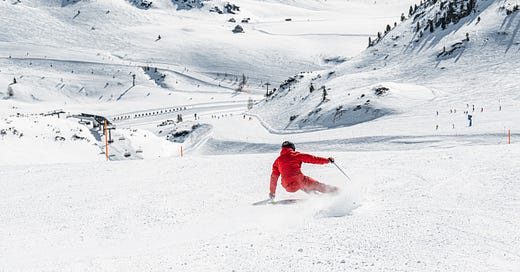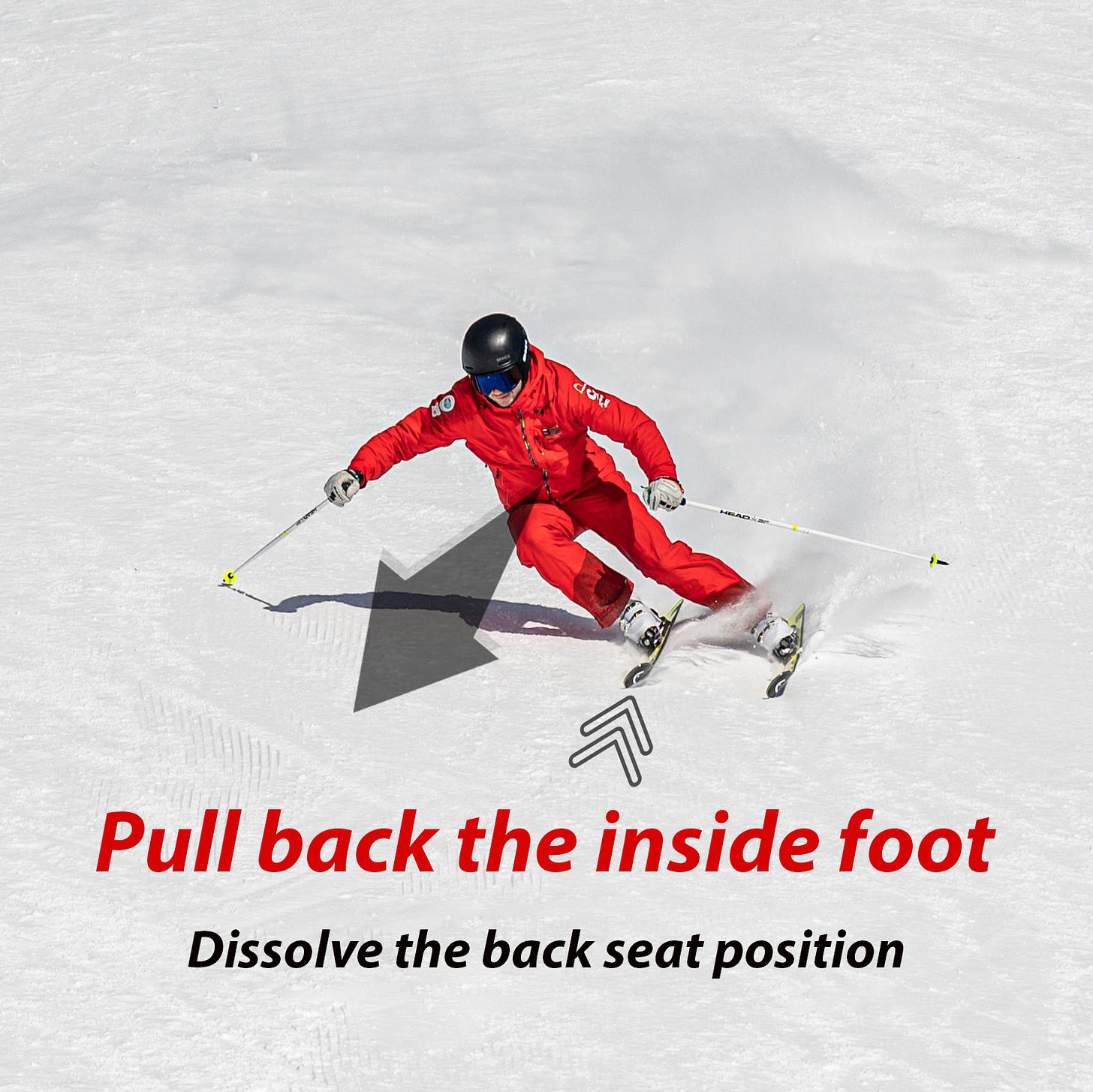Why the back seat position is a good thing if you master this ski move
Take advantage of your light feet at the turn transition...
Many skiers shy away from the infamous back seat position. And rightly so... Leaning backwards on skis increases the risk of losing control or even a nasty crash.
But what if I told you that at higher speeds, it is not that bad at all to end up in the back seat position at the end of every turn? Better still, what if I encouraged you to actively seek this position?
Imagine the following situation for a moment: you're carving at high speed on a freshly groomed track. You feel the adrenaline coursing through your body as the wind whips past your ears…
As you manoeuvre the skis to the left from your ankles, you sharpen the curve by relaxing your inside leg. The inner half of your body lightens, causing your left knee to move up towards your chest. Thanks to that inner knee moving upwards, you lower the distance of your hip from the snow and increase your edge angle.
As you ease your inner leg, you also feel a tension building in the outer half of your body. You feel the pressure building up on your outside ski.
Your right leg is stretched and tightened, allowing your right foot to surf against centripetal force, which wants to sling your skis to the inside of the turn (but is impossible to do so because your strong outside leg is offering enough resistance).
Your right ski is now a platform against which you can balance, so to speak, while your inside leg controls the radius of your carving turn.
Surf against your outside ski and let your inside ski handle the intelligent work…
Now you’re all set up for the turn transition. You start by relaxing your outside leg. After all, by flexing your outside leg (= flex to release) you allow centripetal force to push your outside ski back towards you. Your outside leg shortens, and you start moving from long leg/short leg to a new position with two short legs.
This is how your right foot ends up in a position right next to your left foot. While both feet are light, both skis are also set flat. You’re in a compact position, with both knees and ankles deeply flexed, ready to complete the edge change. You’re now in the perfect ‘sweet spot’ to start entering your next turn with a rolling action from your ankles and knees…
Hold on a minute… am I not in the back seat during such a deeply flexed position?
This is the crucial point many skiers struggle with. The non-believers in a compact edge change will say the feet are now in front of the hip. In other words, you’re in that dreadful back seat position…
And indeed, if you would maintain this position, you’re likely to run into trouble. Your turn entry might become less clean as the tips can no longer cut into the snow. You might even go down crashing hard, with your skis swinging in all directions, to the tune of jeers from skiers whizzing past you who would rather laugh at you than offer a helping hand… What a catastrophe...
However, the key is not avoiding the back seat position. You need to actively seek the back seat position by keeping your edge change compact, keep the moment you’re in that position exceptionally short, and then dissolve the back seat position via adjusting your front-aft balance.
In other words, try to get out of that back seat position as soon as possible.
How can I get out of the back seat position?
During an edge change, you should never hesitate. The moment where both skis are flat, with two deeply flexed knees, should only last a very, very short time!
But the most important thing is that a recentring of the feet takes place as quickly as possible. You want to get the feet behind the hip again, which will dissolve the back seat position.
You could do this by stretching both legs to bring the hip back over the feet. However, by doing so, you unnecessarily lift your body's centre of gravity again, worsening your balance.
By actively stretching both legs, you also press the skis into the snow, making it very difficult for yourself to roll the skis over from the ankles at the edge change. So to avoid this, we want to keep both feet light at the edge change.
The better solution? Slide your new inside ski backwards after the edge change, by actively pulling your inside foot backwards. It is the easiest way to quickly regain pressure on the tips of your skis at the start of a new turn. By doing this, you avoid getting stuck in the back seat position.
The other benefit is that by performing this movement, you prevent your hip from being trapped in a locked position. This is because on steeper terrain and with dynamic movements, your inside ski tends to slide forward.
What's the science behind this? The geometry of the boot and biomechanics at play always prefer to push the inside ski forward so that the ankles stay at the same angle when rounding a turn. But if you let the inside ski slide forward too much, it creates a sagittal split, trapping your hip and preventing you from building the right amount of angulation or counterbalance.
Pull the inside foot back to dissolve the back seat position
Pulling your inside foot backwards is done through a process of dorsiflexion, actively closing the ankle further. To pull the foot back, you also activate the hamstrings. If we close the ankle strongly, we do not allow the boot to move forward due to the geometry of the shoe. So keeping that foot under your hips is important for balance, control and front-to-back alignment.
At higher speeds, you can always expect to find yourself in a back seat position for a very brief moment while skiing. In fact, it is even a good thing if you feel this because it means you’re skiing very compact at the edge change, which will make your turns aggressive yet elegant at the same time.
During that brief ‘being in the back seat’ moment the feet are also very light. Take advantage of this weightlessness by immediately launching two movements every single time you feel you’re in the back seat:
Quickly roll the skis over from both feet to enter the new turn (without hesitation)
Pull the (new) inside foot backwards
Thanks to these movements, you will become a genius at managing your front-aft balance, and you will never stay in the back seat position for too long.
Try it out, you got this! 👊
Enjoy cruising!
Seen my video tutorial on compact edge changes yet? Check it out below!







awesome tip, many thanks Niels